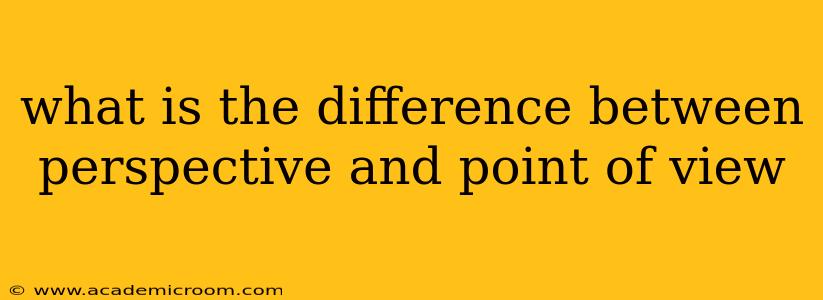What's the Difference Between Perspective and Point of View?
The terms "perspective" and "point of view" are often used interchangeably, leading to confusion. While closely related, they have distinct meanings, particularly within the realms of writing, art, and critical thinking. Understanding the nuances between them is crucial for clear communication and insightful analysis.
Point of View (POV): This refers primarily to the narrator's position in a story or narrative. It dictates who is telling the story and how they experience and relate the events. We typically categorize POV in writing as:
- First-person: The narrator is a character within the story, using "I" or "we." This limits the reader's knowledge to the narrator's experiences and thoughts.
- Second-person: The narrator addresses the reader directly as "you," placing the reader into the story as the protagonist. This is less common.
- Third-person limited: The narrator focuses on the thoughts and feelings of a single character.
- Third-person omniscient: The narrator has access to the thoughts and feelings of multiple characters and a broader understanding of the story's events.
Perspective: This is broader and encompasses the lens through which something is viewed or understood. It considers the individual's beliefs, experiences, background, and biases that shape their understanding. Perspective isn't just about who is telling the story, but how they see and interpret it. It includes:
- Personal beliefs: A person's religious, political, or social views significantly influence their perspective.
- Cultural background: Different cultures offer unique ways of perceiving the world, affecting perspectives on various issues.
- Past experiences: Personal history shapes how individuals interpret new information and situations.
- Emotional state: One's emotional state at the time can drastically color their perspective.
How do they work together?
Point of view is a tool used to convey perspective. The chosen point of view directly influences how the reader experiences the perspective of the narrator or characters. For example:
- A first-person account of a traumatic event will directly convey the character's emotional perspective.
- A third-person omniscient narrator can offer multiple perspectives, allowing the reader to compare and contrast different viewpoints.
Examples Illustrating the Difference:
Imagine a car accident.
- Point of View: The story could be told from the perspective of the driver of one car (first-person), a witness (first-person or third-person limited), or an omniscient narrator who knows the thoughts and feelings of everyone involved (third-person omniscient).
- Perspective: The driver might feel guilt and responsibility, while the witness might see it as a simple accident. The perspective of a police officer investigating the incident would differ again, focusing on legal aspects.
Frequently Asked Questions (PAAs):
Can a story have multiple perspectives but only one point of view?
Yes, absolutely. A third-person limited point of view might focus on one character's experiences, but the reader can still infer or be explicitly shown the perspectives of other characters through their actions and dialogue. The narrator is limited in direct access to their thoughts and feelings, but still conveys their perspective.
Is perspective subjective, while point of view is objective?
Perspective is inherently subjective, shaped by individual experiences and beliefs. Point of view, while a choice made by the author (and thus arguably subjective in creation), is a structural element within the narrative itself and can be analyzed objectively in terms of its type (first-person, third-person omniscient, etc.).
How does understanding the difference between perspective and point of view improve writing?
Recognizing the distinction enables writers to craft richer, more nuanced narratives. By carefully selecting a point of view and considering the perspectives of their characters, writers create more believable and engaging stories. It allows for deeper exploration of themes and more complex character development.
In short, point of view is the who and how of storytelling, while perspective is the lens through which the story is interpreted and understood, impacting both the narrator and the reader. Understanding this difference is key to crafting compelling narratives and critically analyzing any form of communication.
